Notes: The construction of a railway north from Birmingham Snow Hill to Priestfield, where it would meet the Oxford, Worcester & Wolverhampton Railway (OW&WR) was authorised on 3 August 1846 to the Birmingham, Wolverhampton & Dudley Railway (BW&DR). The BW&DR favoured leasing the line to the Great Western Railway (GWR) from the offset as it planned the line to be constructed to the GWR’s broad gauge (7ft 0¼in) rather than what was, increasingly, the standard gauge (4ft 8½in). Negotiations with the GWR in regard to leasing and running the line started on 12 November 1846, only months after the railway company had been incorporated, and by Act of Parliament of 31 August 1848 the BW&DR was purchased by the GWR prior to any construction taking place. Construction of the line was started by the GWR during 1851 and by June 1852 the original Act was due to lapse and the GWR successfully applied to Parliament for a 3½-year extension to the original Act. The GWR had attempted not to construct the line at all preferring to negotiate with the London & North Western Railway (LNWR) to gain running rights along the Stour Valley line; negotiations failed as the, ever suspicious, LNWR was attempting to delay the GWR reaching its ultimate goal, Liverpool.

Construction was complete by the summer of 1854 and the line was duly inspected by Captain Sir Douglas Strutt-Galton in August. It is not recorded whether or not the inspection was a success, but, the following day a tubular bridge over the turnpike road at Winson Green collapsed following the passage of a contractor’s locomotive working a ballast train. Isambard Kingdom Brunel visited the line the following day and a thorough inspection of the bridges along the route with John Mc Clean, the resident engineer, resulted in five of them being condemned. The opening of the line had been set for 1 September 1854 but this was now unachievable as remedial work on the structures was to take some months. Following the strengthening of the five bridges the line was again inspected and passed fit for traffic, opening on 14 November 1854.
The station at Hockley was reached from Icknield Street and it was provided with a small courtyard. The somewhat dour three-storey brick building with segmental-arched openings under a hipped roof was designed to stretch upward to the elevated platforms. The entrance and booking.jpg) hall were in a single-storey brick structure contiguous with the taller building and under a hipped roof with chamfered ends. The two original elevated platforms were connected via a subway; the up platform handled trains to Birmingham and down trains to Wolverhampton called at the other platform. The majority of the station facilities were provided on the up side with various offices and a waiting room. The down platform was provided with a waiting room only. The area around the station had been earmarked by the GWR for the handling of goods for central Birmingham and by the mid 1880s the original goods shed, directly to the south of the down platform, had been supplemented by two colossal warehouses east and west of the station. The expanse of associated lines and sidings had grown enormously by the turn of the century and, with further increases in traffic, the yard and its three warehouses were unable to cope. hall were in a single-storey brick structure contiguous with the taller building and under a hipped roof with chamfered ends. The two original elevated platforms were connected via a subway; the up platform handled trains to Birmingham and down trains to Wolverhampton called at the other platform. The majority of the station facilities were provided on the up side with various offices and a waiting room. The down platform was provided with a waiting room only. The area around the station had been earmarked by the GWR for the handling of goods for central Birmingham and by the mid 1880s the original goods shed, directly to the south of the down platform, had been supplemented by two colossal warehouses east and west of the station. The expanse of associated lines and sidings had grown enormously by the turn of the century and, with further increases in traffic, the yard and its three warehouses were unable to cope.
During the early part of the twentieth century the GWR realised that capacity limitations between Snow Hill and Handsworth Junction had to be addressed and, following the rebuilding of Snow Hill station, set about quadrupling the running lines from Hockley through to Handsworth Junction. The main up and down passenger lines were grouped together to the north with, what became known as, the ‘relief up and down’ lines to the south. The new alignment resulted in partial demolition of the original station with the main building and a portion of the up platform retained, the platform being extended west for a considerable length. The down platform was completely rebuilt as an island following the curvature of the line to the west. The subway was provided with hydraulic lifts, presumably used for the movement of small consignments not handled in the goods warehouses. A range of nondescript brick-built single-storey waiting rooms and offices was provided on the new down platform sheltered by a large GWR canopy; this was of pitched profile, fronted by a modest serrated valance, and the gables featured a deep serrated valance curving downwards at both ends.
The vast goods yards necessitated a compromise at Hockley during the 1912 rebuild as the engineers were given only enough room to provide three platform faces for the, now, four running lines through the station. The main up passenger line (Birmingham direction) and the relief up and down lines (Wolverhampton direction) were provided with platform faces; the down main passenger line ran through the centre of the up main and up relief lines. Gas lighting was provided along the length of both platforms with water columns situated at either end of the island platform and at the Birmingham end of the up platform. Traditional GWR style running-in-boards were situated at the end of both platforms. At the ‘Big Four’ Grouping of 1 January 1923 Hockley remained under the control of the GWR.
Examination of Bradshaw December 1895 shows a regular service in both up (Snow Hill) direction and down services. On Monday-to-Friday in the up direction there were 43 workings, with one extra on a Saturday, mainly local services terminating at Birmingham Snow Hill but four 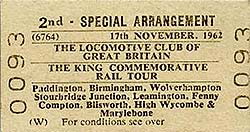 trains per day ran through to London Paddington, seven to Leamington Spa and a single service at 12.50pm to Bournemouth East. In the down direction there were 44 services on Monday-to-Friday, with one extra on Saturday, again mainly local services to Dudley, Halesowen, Stourbridge Junction and Wolverhampton Low Level. A handful of the trains bound for Wolverhampton were long distance services from London Paddington with one service per day for Holyhead, conveying mail for Ireland, and one for Liverpool Landing Stage for passage to America. The station had a frequent Sunday service with 19 trains calling in each direction between 7.20am and 10.35 pm. Six of the up (Snow Hill) direction services were through trains to London Paddington with the remaining services to Snow Hill, Solihull, Leamington or Knowle. In the down direction a morning and afternoon service ran through to Liverpool Landing Stage with the remaining services mainly split between Dudley, Worcester and Wolverhampton Low Level. By 1949, the May to September timetable shows an increase in the up passenger service with 51 up (Snow Hill) direction services on Monday-to-Friday and one extra on a Saturday. A reduction is seen in the down passenger service with 41 Monday-to-Friday services but a mere 36 on Saturday. The station still had a healthy Sunday service with 21 services in the up direction and 24 in the down (Wolverhampton) direction. trains per day ran through to London Paddington, seven to Leamington Spa and a single service at 12.50pm to Bournemouth East. In the down direction there were 44 services on Monday-to-Friday, with one extra on Saturday, again mainly local services to Dudley, Halesowen, Stourbridge Junction and Wolverhampton Low Level. A handful of the trains bound for Wolverhampton were long distance services from London Paddington with one service per day for Holyhead, conveying mail for Ireland, and one for Liverpool Landing Stage for passage to America. The station had a frequent Sunday service with 19 trains calling in each direction between 7.20am and 10.35 pm. Six of the up (Snow Hill) direction services were through trains to London Paddington with the remaining services to Snow Hill, Solihull, Leamington or Knowle. In the down direction a morning and afternoon service ran through to Liverpool Landing Stage with the remaining services mainly split between Dudley, Worcester and Wolverhampton Low Level. By 1949, the May to September timetable shows an increase in the up passenger service with 51 up (Snow Hill) direction services on Monday-to-Friday and one extra on a Saturday. A reduction is seen in the down passenger service with 41 Monday-to-Friday services but a mere 36 on Saturday. The station still had a healthy Sunday service with 21 services in the up direction and 24 in the down (Wolverhampton) direction.
The station appears to have remained relatively unchanged during the years from rebuilding to the end of the Second World War; it seemingly escaped enemy action during the Birmingham Blitz of 1941, which seems quite remarkable owing to its proximity to the potential target of the goods warehouses. On 1 January 1948 the rail network was nationalised with Hockley coming under the control of British Railways (BR) Western Region (WR). During the London Midland Region’s (LMR) electrification programme of the West Coast main line (WCML), started in 1958, the line saw an increase in passenger services as many extra trains were run via WR metals to compensate for the reduction in services on the WCML. Although this did not affect the service at Hockley it seemed to cement the former GWR route as still being a primary main line. Plans revealed by the BR (WR) in the early 1960s for the rebuilding of Snow Hill and the introduction of new diesel Pullman services all pointed towards the future being bright. On 1 January 1963 boundaries of some BR regions were redrawn and Hockley station came under the control of BR (LMR), and with the completion of the electrification programme and the linking of the main line from Paddington to Birmingham New Street the route north of Snow Hill was considered secondary.
The first service reduction occurred on 15 May 1964 with the withdrawal of the Snow Hill to Dudley working, followed in 1966 by BR (LMR) issuing a proposal to close the route, and all stations, in its entirety. In 1966 there were 24 trains in each direction to and from Wolverhampton, supplemented by 14 services to Stourbridge calling at Hockley with around 2,000 people per day travelling on these trains. Objections were posted to the Transport Users Consultative Committee (TUCC) and the case for closure was discussed on 20 September 1966. The recommendation of the TUCC was that the line should remain open as closure would cause ‘extreme hardship’. This ruling caused the LMR to change tactics with the announcement that as of 4 March 1967 the main line trains along the whole route would be withdrawn and freight trains diverted along other routes. On 15 November 1967 the Minister of Transport, Barbara Castle, responded to BR’s closure application refusing to allow the closure of Wolverhampton to Snow Hill and the branch to Langley Green whilst allowing the closure of the southern section from Snow Hill towards Stratford and Leamington. With the lack of through freight and express passenger services the four-track section between Handsworth and Hockley could no longer be justified, so in August 1968 it was announced that the main lines would be closed and all remaining traffic concentrated on the relief lines. supplemented by 14 services to Stourbridge calling at Hockley with around 2,000 people per day travelling on these trains. Objections were posted to the Transport Users Consultative Committee (TUCC) and the case for closure was discussed on 20 September 1966. The recommendation of the TUCC was that the line should remain open as closure would cause ‘extreme hardship’. This ruling caused the LMR to change tactics with the announcement that as of 4 March 1967 the main line trains along the whole route would be withdrawn and freight trains diverted along other routes. On 15 November 1967 the Minister of Transport, Barbara Castle, responded to BR’s closure application refusing to allow the closure of Wolverhampton to Snow Hill and the branch to Langley Green whilst allowing the closure of the southern section from Snow Hill towards Stratford and Leamington. With the lack of through freight and express passenger services the four-track section between Handsworth and Hockley could no longer be justified, so in August 1968 it was announced that the main lines would be closed and all remaining traffic concentrated on the relief lines.
The introduction of the May timetable in 1969 saw all intermediate stations between Wolverhampton Low Level and Birmingham Snow Hill demoted to unstaffed halts. Monday 4 March 1968 was a significant day for the future of Hockley with withdrawal of services south of Snow Hill and the tunnel and lines through to Moor Street taken out of use; coupled with this services from Stourbridge Junction were diverted into New Street although a shuttle was introduced between Snow Hill and Langley Green to connect with it. On the same day the service frequency was drastically reduced, this not requiring any permission from the TUCC or the  Minister for Transport. The station now had just three morning and three evening services in each direction with a lunchtime Saturday-only service to cater for shoppers, on the Wolverhampton line; four down (Wolverhampton direction) and five up services ran to and from Langley Green. By the end of 1970 the station had a very run-down feel with vandalism prevalent, and passenger numbers had dwindled to less than a tenth of what they had been just four years previously. The newly formed West Midlands Public Transport Authority (WMPTA) recognised the importance of the route although as it did not become responsible for local rail services until 1972 it could not react to the next move by BR. Closure notices were posted by BR on 31 March 1971 with the final date for objections to be received as 19 May 1971. The TUCC received 199 objections in total and on 25 May, they, along with representatives from BR and WMPTE (the Executive body of the WMPTA) inspected the route and all the stations travelling from Snow Hill by train to Wolverhampton; ironically they returned by bus! A Public Hearing was held at the Rainbow Suite in Birmingham on 14 July 1971 for objections to be presented and for a decision to be made on the future of the line. One such objection was received from H.M. of Smethwick, a regular commuter to Hockley, read: ‘I am a user of the train between Smethwick West and Hockley for the purpose of slaving. I wish to object to the closure of this service. It will cause me great hardship because I detest the Midland Red Bus service and the price they are charging is disgusting’. The statement issued by the TUCC could not have been clearer ‘the addition of displaced rail passengers at these times would aggravate an already critical situation and would result in hardship for all concerned’. Minister for Transport. The station now had just three morning and three evening services in each direction with a lunchtime Saturday-only service to cater for shoppers, on the Wolverhampton line; four down (Wolverhampton direction) and five up services ran to and from Langley Green. By the end of 1970 the station had a very run-down feel with vandalism prevalent, and passenger numbers had dwindled to less than a tenth of what they had been just four years previously. The newly formed West Midlands Public Transport Authority (WMPTA) recognised the importance of the route although as it did not become responsible for local rail services until 1972 it could not react to the next move by BR. Closure notices were posted by BR on 31 March 1971 with the final date for objections to be received as 19 May 1971. The TUCC received 199 objections in total and on 25 May, they, along with representatives from BR and WMPTE (the Executive body of the WMPTA) inspected the route and all the stations travelling from Snow Hill by train to Wolverhampton; ironically they returned by bus! A Public Hearing was held at the Rainbow Suite in Birmingham on 14 July 1971 for objections to be presented and for a decision to be made on the future of the line. One such objection was received from H.M. of Smethwick, a regular commuter to Hockley, read: ‘I am a user of the train between Smethwick West and Hockley for the purpose of slaving. I wish to object to the closure of this service. It will cause me great hardship because I detest the Midland Red Bus service and the price they are charging is disgusting’. The statement issued by the TUCC could not have been clearer ‘the addition of displaced rail passengers at these times would aggravate an already critical situation and would result in hardship for all concerned’.

The sudden withrawal of the service even caught the timetable printers out, the note at the top of this B.R. LMR timetable for May 1973 does state the service was under consideration for withdrawal whereas in reality it had already disappeared in March 1972
Despite objections, Peter Walker -the Minister responsible for transport within the Department of the Environment - granted permission for closure to be implemented with a date quickly set for 4 March. On the final day trains were expected to be heavily patronised, so, instead of being the usual single-car DMU the trains were strengthened to 3-car units with BR issuing souvenir tickets. The final Wolverhampton-bound train called at Hockley at around 17.50 with the final Birmingham-bound service departing at around 18.10. A final service, hauled by a Class 47 locomotive, departed Snow Hill shortly after the final DMU but did not stop at the station.
Shortly after the final services ran and the lines fell silent the WMPTA moved to protect the .jpg) trackbed from any future development, adopting this as official policy on 31 October 1973. The Authority and its Executive body worked tirelessly for the next two decades to reintroduce rail services through the site of Hockley station and on 25 September 1995 services once again began to run from Snow Hill to Kidderminster. The trackbed of the relief lines would be brought back into use from 31 May 1999 as Line 1 of the Midland Metro with a new Rail/Metro interchange situated on the opposite side of Icknield Street, close to the site of the original Hockley station. trackbed from any future development, adopting this as official policy on 31 October 1973. The Authority and its Executive body worked tirelessly for the next two decades to reintroduce rail services through the site of Hockley station and on 25 September 1995 services once again began to run from Snow Hill to Kidderminster. The trackbed of the relief lines would be brought back into use from 31 May 1999 as Line 1 of the Midland Metro with a new Rail/Metro interchange situated on the opposite side of Icknield Street, close to the site of the original Hockley station.
The station site today can still be located off what is now known as the Middle Ring Road (A4540). The small courtyard is sextant and was, up until recently, in use as a timber yard but since its closure a large amount of domestic waste has been dumped in it. The subway entrance, access to the ground level storage rooms and the white glazed bricks of the booking hall are all still evident; sadly access to the up platform steps is barred by the sheer volume of waste. At platform level very little remains save for a portion of the retaining wall of the main building with all traces of the platforms having been swept away. The line today is very busy with London Midland and Chiltern Railway services using the heavy rail side of the four-track formation and a frequent Midland Metro using the light rail tram side. A new station – Jewellery Quarter - was opened close to the site of Hockley station and the Hockley site can be seen from its platforms.
Tickets from Michael Stewart, route map by Alan Young and Totem from Richard Furness
Sources:
- Bradshaw's Railway Guide December 1895 - Middleton Press
- Bradshaw's Railway Guide July 1922 - Guild Publishing
- British Railways (WR) May - September timetble 1949
- British Rail (LMR) 3 May 1971 - 30 April 1972 timetable
- Forgotten Railways: Volume 10, The West Midlands - Rex Christinsen - David & Charles Publishing 1985
- A Regional History of the Railways of Great Britain - Volume 7 The West Midlands - Rex Christiansen - David St John Thomas Publisher 1991
- A Century of Railways around Birmingham and the West Midlands Vol 1,2 & 3 - John Boynton - Mid England Books Publisher 1999
- From Main Line To Metro - John Boynton - Mid England Books 2001
-
To see the
other stations on the Birmingham Snow Hill - Chester General line
click on the station name: Birmingham Snow Hill, Winson Green,
Handsworth, The Hawthorns, West Bromwich, Swan Village,
Wednesbury, Bradley & Moxley, Bilston, Priestfield, Wolverhampton Low Level, Dunstall Park, Stafford Road, New Hadley Halt, Admaston Halt, Walcot,
Upton Magna, Abbey Foregate, Shrewsbury S&C,
Leaton, Oldwoods Halt, Baschurch, Stanwardine Halt, Haughton Halt,
Rednal & West Felton, Whittington Low Level, Weston Rhyn, Whitehurst Halt, Rhosymedre, Rhosymedre Halt, Wynville Halt, Rhos, Johnstown & Hafod, Rhosrobin Halt, Gresford, Rossett, Pulford, Balderton and Saltney |



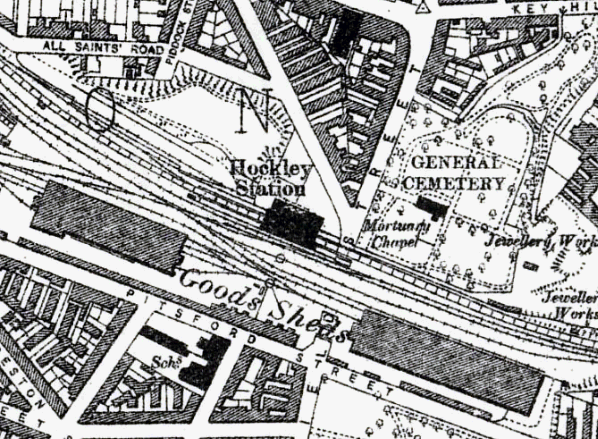

 The 1904 1:2500 OS County map shows how the station altered during the quadrupling of the lines through the station with the orientation of the down platform changing significantly
The 1904 1:2500 OS County map shows how the station altered during the quadrupling of the lines through the station with the orientation of the down platform changing significantly 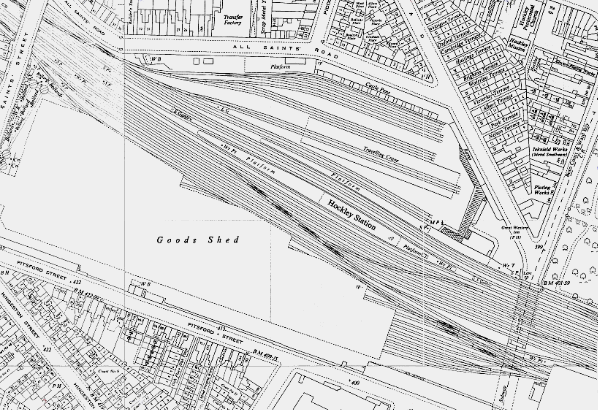
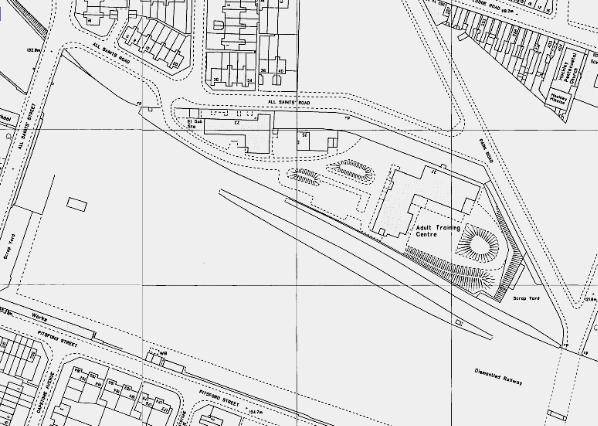
totem.gif)

.jpg) hall were in a single-storey brick structure contiguous with the taller building and under a hipped roof with chamfered ends. The two original elevated platforms were connected via a subway; the up platform handled trains to Birmingham and down trains to Wolverhampton called at the other platform. The majority of the station facilities were provided on the up side with various offices and a waiting room. The down platform was provided with a waiting room only. The area around the station had been earmarked by the GWR for the handling of goods for central Birmingham and by the mid 1880s the original goods shed, directly to the south of the down platform, had been supplemented by two colossal warehouses east and west of the station. The expanse of associated lines and sidings had grown enormously by the turn of the century and, with further increases in traffic, the yard and its three warehouses were unable to cope.
hall were in a single-storey brick structure contiguous with the taller building and under a hipped roof with chamfered ends. The two original elevated platforms were connected via a subway; the up platform handled trains to Birmingham and down trains to Wolverhampton called at the other platform. The majority of the station facilities were provided on the up side with various offices and a waiting room. The down platform was provided with a waiting room only. The area around the station had been earmarked by the GWR for the handling of goods for central Birmingham and by the mid 1880s the original goods shed, directly to the south of the down platform, had been supplemented by two colossal warehouses east and west of the station. The expanse of associated lines and sidings had grown enormously by the turn of the century and, with further increases in traffic, the yard and its three warehouses were unable to cope. trains per day ran through to London Paddington, seven to Leamington Spa and a single service at 12.50pm to Bournemouth East. In the down direction there were 44 services on Monday-to-Friday, with one extra on Saturday, again mainly local services to Dudley, Halesowen, Stourbridge Junction and Wolverhampton Low Level. A handful of the trains bound for Wolverhampton were long distance services from London Paddington with one service per day for Holyhead, conveying mail for Ireland, and one for Liverpool Landing Stage for passage to America. The station had a frequent Sunday service with 19 trains calling in each direction between 7.20am and 10.35 pm. Six of the up (Snow Hill) direction services were through trains to London Paddington with the remaining services to Snow Hill, Solihull, Leamington or Knowle. In the down direction a morning and afternoon service ran through to Liverpool Landing Stage with the remaining services mainly split between Dudley, Worcester and Wolverhampton Low Level. By 1949, the May to September timetable shows an increase in the up passenger service with 51 up (Snow Hill) direction services on Monday-to-Friday and one extra on a Saturday. A reduction is seen in the down passenger service with 41 Monday-to-Friday services but a mere 36 on Saturday. The station still had a healthy Sunday service with 21 services in the up direction and 24 in the down (Wolverhampton) direction.
trains per day ran through to London Paddington, seven to Leamington Spa and a single service at 12.50pm to Bournemouth East. In the down direction there were 44 services on Monday-to-Friday, with one extra on Saturday, again mainly local services to Dudley, Halesowen, Stourbridge Junction and Wolverhampton Low Level. A handful of the trains bound for Wolverhampton were long distance services from London Paddington with one service per day for Holyhead, conveying mail for Ireland, and one for Liverpool Landing Stage for passage to America. The station had a frequent Sunday service with 19 trains calling in each direction between 7.20am and 10.35 pm. Six of the up (Snow Hill) direction services were through trains to London Paddington with the remaining services to Snow Hill, Solihull, Leamington or Knowle. In the down direction a morning and afternoon service ran through to Liverpool Landing Stage with the remaining services mainly split between Dudley, Worcester and Wolverhampton Low Level. By 1949, the May to September timetable shows an increase in the up passenger service with 51 up (Snow Hill) direction services on Monday-to-Friday and one extra on a Saturday. A reduction is seen in the down passenger service with 41 Monday-to-Friday services but a mere 36 on Saturday. The station still had a healthy Sunday service with 21 services in the up direction and 24 in the down (Wolverhampton) direction. Minister for Transport. The station now had just three morning and three evening services in each direction with a lunchtime Saturday-only service to cater for shoppers, on the Wolverhampton line; four down (Wolverhampton direction) and five up services ran to and from Langley Green. By the end of 1970 the station had a very run-down feel with vandalism prevalent, and passenger numbers had dwindled to less than a tenth of what they had been just four years previously. The newly formed West Midlands Public Transport Authority (WMPTA) recognised the importance of the route although as it did not become responsible for local rail services until 1972 it could not react to the next move by BR. Closure notices were posted by BR on 31 March 1971 with the final date for objections to be received as 19 May 1971. The TUCC received 199 objections in total and on 25 May, they, along with representatives from BR and WMPTE (the Executive body of the WMPTA) inspected the route and all the stations travelling from Snow Hill by train to Wolverhampton; ironically they returned by bus! A Public Hearing was held at the Rainbow Suite in Birmingham on 14 July 1971 for objections to be presented and for a decision to be made on the future of the line. One such objection was received from H.M. of Smethwick, a regular commuter to Hockley, read: ‘I am a user of the train between Smethwick West and Hockley for the purpose of slaving. I wish to object to the closure of this service. It will cause me great hardship because I detest the Midland Red Bus service and the price they are charging is disgusting’. The statement issued by the TUCC could not have been clearer ‘the addition of displaced rail passengers at these times would aggravate an already critical situation and would result in hardship for all concerned’.
Minister for Transport. The station now had just three morning and three evening services in each direction with a lunchtime Saturday-only service to cater for shoppers, on the Wolverhampton line; four down (Wolverhampton direction) and five up services ran to and from Langley Green. By the end of 1970 the station had a very run-down feel with vandalism prevalent, and passenger numbers had dwindled to less than a tenth of what they had been just four years previously. The newly formed West Midlands Public Transport Authority (WMPTA) recognised the importance of the route although as it did not become responsible for local rail services until 1972 it could not react to the next move by BR. Closure notices were posted by BR on 31 March 1971 with the final date for objections to be received as 19 May 1971. The TUCC received 199 objections in total and on 25 May, they, along with representatives from BR and WMPTE (the Executive body of the WMPTA) inspected the route and all the stations travelling from Snow Hill by train to Wolverhampton; ironically they returned by bus! A Public Hearing was held at the Rainbow Suite in Birmingham on 14 July 1971 for objections to be presented and for a decision to be made on the future of the line. One such objection was received from H.M. of Smethwick, a regular commuter to Hockley, read: ‘I am a user of the train between Smethwick West and Hockley for the purpose of slaving. I wish to object to the closure of this service. It will cause me great hardship because I detest the Midland Red Bus service and the price they are charging is disgusting’. The statement issued by the TUCC could not have been clearer ‘the addition of displaced rail passengers at these times would aggravate an already critical situation and would result in hardship for all concerned’.
.jpg) trackbed from any future development, adopting this as official policy on 31 October 1973. The Authority and its Executive body worked tirelessly for the next two decades to reintroduce rail services through the site of Hockley station and on 25 September 1995 services once again began to run from Snow Hill to Kidderminster. The trackbed of the relief lines would be brought back into use from 31 May 1999 as Line 1 of the Midland Metro with a new Rail/Metro interchange situated on the opposite side of Icknield Street, close to the site of the original Hockley station.
trackbed from any future development, adopting this as official policy on 31 October 1973. The Authority and its Executive body worked tirelessly for the next two decades to reintroduce rail services through the site of Hockley station and on 25 September 1995 services once again began to run from Snow Hill to Kidderminster. The trackbed of the relief lines would be brought back into use from 31 May 1999 as Line 1 of the Midland Metro with a new Rail/Metro interchange situated on the opposite side of Icknield Street, close to the site of the original Hockley station.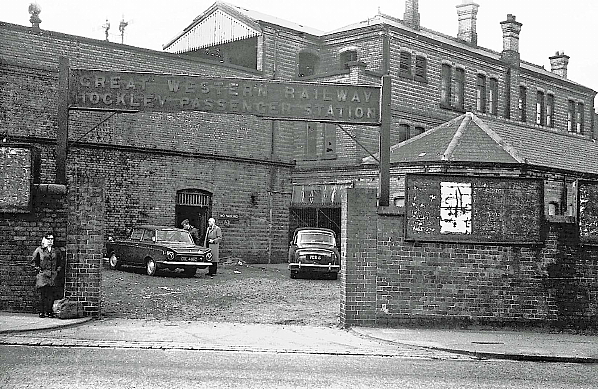
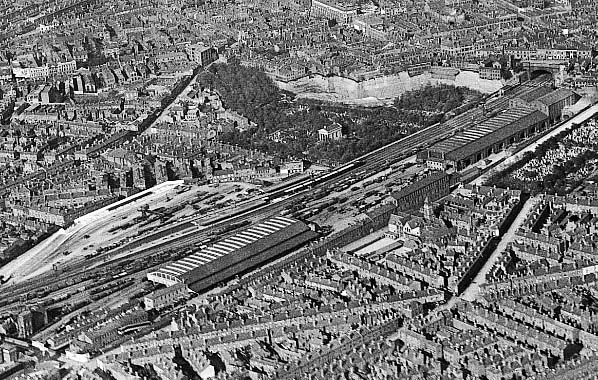
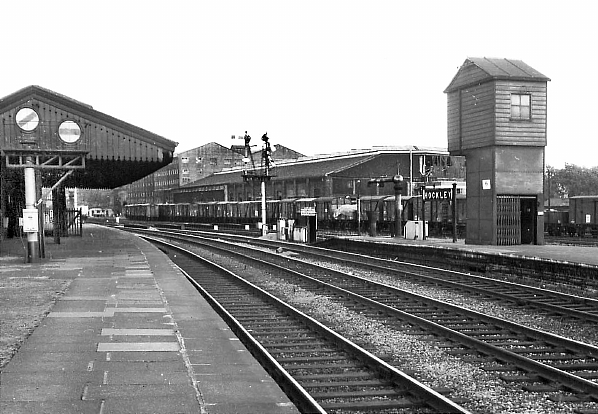
 Looking in the Wolverhampton direction at the station on 5 May 1964 as Manor Class 4-6-0 7821 Ditcheat Manor drifts under the signal gantry heding towards Birmingham. A good number of vans are to be seen in the Hockley Goods Sidings.
Looking in the Wolverhampton direction at the station on 5 May 1964 as Manor Class 4-6-0 7821 Ditcheat Manor drifts under the signal gantry heding towards Birmingham. A good number of vans are to be seen in the Hockley Goods Sidings.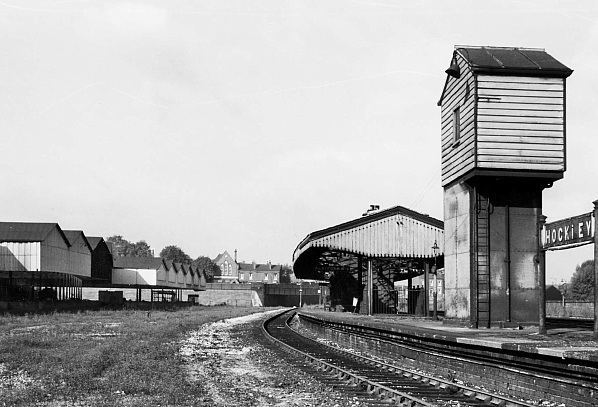
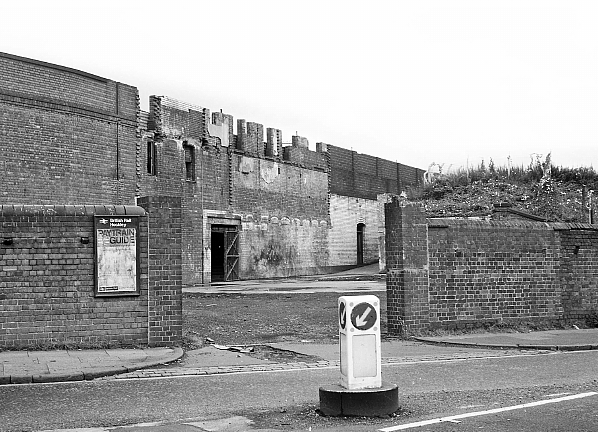
 Similarly at platform level the demolition of the buildings and canopy left a rather desolate and uninviting environment for the would-be traveller. Seen here in October 1971 with a single car DMU heading towards Birmingham on the up passenger relief line, the up and down main passenger lines, to the right of the unit, had been out of use for some time at this point.
Similarly at platform level the demolition of the buildings and canopy left a rather desolate and uninviting environment for the would-be traveller. Seen here in October 1971 with a single car DMU heading towards Birmingham on the up passenger relief line, the up and down main passenger lines, to the right of the unit, had been out of use for some time at this point.
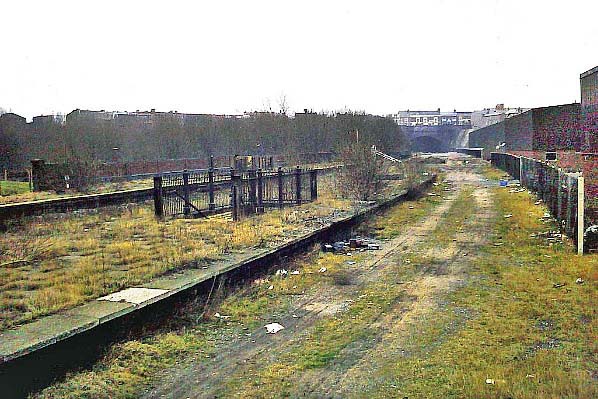 Looking east in the Birmingham direction in 1987 the entrance to the subway on the island platform can clearly be seen; as can the encroachment towards the trackbed from some industrial units constructed on the site of the goods yard. Luckily the WMPTA had protected the trackbed from being used in a similar way.
Looking east in the Birmingham direction in 1987 the entrance to the subway on the island platform can clearly be seen; as can the encroachment towards the trackbed from some industrial units constructed on the site of the goods yard. Luckily the WMPTA had protected the trackbed from being used in a similar way.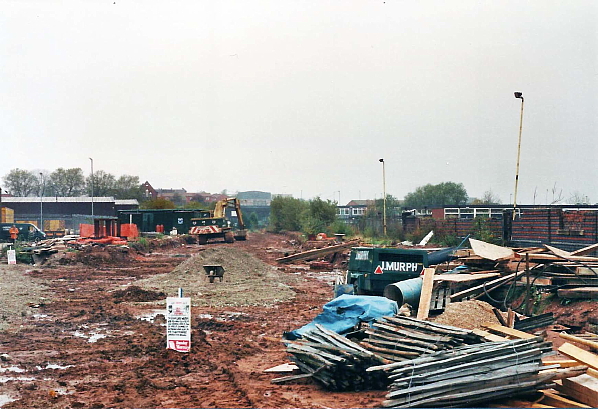
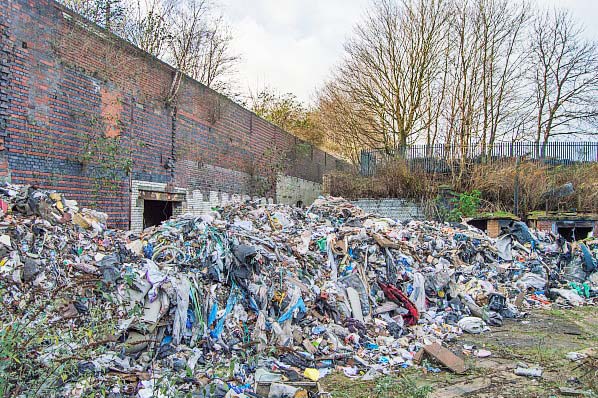 The station forecourt seen from Icknield Street, Middle Ringway A4540, on 30 January 2016. The entrance seen in the gap in the domestic waste is the access to the stairs for the up platform with the wall which backs onto the railway line having been sympathetically repaired.
The station forecourt seen from Icknield Street, Middle Ringway A4540, on 30 January 2016. The entrance seen in the gap in the domestic waste is the access to the stairs for the up platform with the wall which backs onto the railway line having been sympathetically repaired.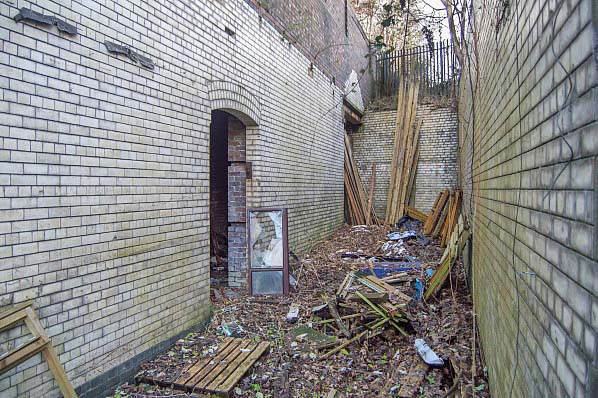

 Home Page
Home Page